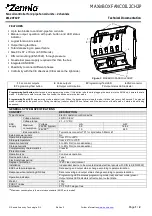9.2 Debug Connector (DBG)
This connector is used for Debug In and Debug Out (see chapter on Debugging). The pinout is described in
Table 9.1 Debug Connec-
tor Pinout on page 15
.
1
2
4
8
6
10
3
5
9
12
13
14
11
15
16
17
18
20
19
SWDIO / TMS
SWCLK / TCK
SWO / TDO
TDI
TRACECLK
TRACE_DATA[0]
TRACE_DATA[1]
TRACE_DATA[2]
TRACE_DATA[3]
#RESET
VTARGET
GND
GND
NC
Cable Detect
NC
NC
GND
GND
GND
Figure 9.3. Debug Connector
Note that the pin-out matches the pin-out of an ARM Cortex Debug+ETM connector, but these are not fully compatible as pin 7 is physi-
cally removed from the Cortex Debug+ETM connector.
Table 9.1. Debug Connector Pinout
Pin number(s)
Function
Note
1
VTARGET
Target voltage on the debugged application.
2
TMS/SDWIO
JTAG TMS or Serial Wire Data I/O
4
TCK/SWCLK
JTAG TCK or Serial Wire clock
6
TDO/SWO
JTAG TDO or Serial Wire Output
8
TDI
JTAG data in
10
#RESET
Target MCU reset
12
TRACECLK
ETM Trace Clock
14
TRACEDATA[0]
ETM Trace Data 0
16
TRACEDATA[1]
ETM Trace Data 1
18
TRACEDATA[2]
ETM Trace Data 2
20
TRACEDATA[3]
ETM Trace Data 3
9
Cable detect
This signal must be pulled to ground by the external debugger or application for ca-
ble insertion detection.
11, 13
NC
Not connected
3, 5, 15, 17, 19
GND
Note:
The Wireless Starter Kit Mainboard does not have an onboard trace emulator. To have trace functionality an external debugger
with such functionality can be connected with Debug In.
Note:
Although the Debug Connector can support JTAG debugging of external targets, the EZR32-series of devices do not support
JTAG.
EZR32WG 915MHz Wireless Starter Kit
Connectors
silabs.com
| Smart. Connected. Energy-friendly.
Rev. 1.2 | 15

















